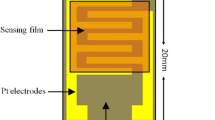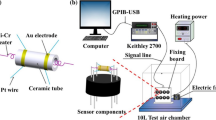Abstract
Hydrogen energy is a resuscitated clean energy source and its sensitive detection in air is crucial due to its very low explosive limit. Metal oxide decorated with noble metal nanoparticles has been used for the enhancement of gas detection and exhibits superior sensitivity. Understanding the intrinsic mechanism of the detection and the enhancement mechanism is thus becoming a fundamental issue for the further development of novel metal/oxide compound gas-sensing materials. However, the correlation between the microstructural evolution, the charge transport and the complex sensing process has not yet been directly revealed and its atomic mechanism is still debatable. In this study, an Au/WO2.7 compound was synthesized and exhibited a strongly enhanced gas sensitivity to many reductive gases, especially H2. Aberration-corrected environmental transmission electron microscopy was used to investigate the atomic-scale microstructural evolution in situ during the reaction between H2 and Au/WO2.7 compound. Swing and sintering processes of the Au particles on the WO2.7 surface were observed under heating and gaseous environments, and no injection of hydrogen atoms was suggested. First principle calculations verified the swing and sintering processes, and they can be explained by the enhancement of H2 sensitivity.

Similar content being viewed by others
References
Yin, X. T.; Zhou, W. D.; Li, J.; Wang, Q.; Wu, F. Y.; Dastan, D.; Wang, D.; Garmestani, H.; Wang, X. M.; ţălu, Ş. A highly sensitivity and selectivity Pt-SnO2 nanoparticles for sensing applications at extremely low level hydrogen gas detection. J. Alloys Compd. 2019, 805, 229–236.
Chen, L.; Tsang, S. C. Ag doped WO3-based powder sensor for the detection of NO gas in air. Sens. Actuators. B Chem. 2003, 89, 68–75.
Grisel, R. J. H.; Weststrate, C. J.; Goossens, A.; Crajé, M. W. J.; van der Kraan, A. M.; Nieuwenhuys, B. E. Oxidation of CO over Au/MOx/Al2O3 multi-component catalysts in a hydrogen-rich environment. Catal. Today. 2002, 72, 123–132.
Huang, K.; Zhang, Q.; Yang, F.; He, D. Y. Ultraviolet photo-conductance of a single hexagonal WO3 nanowire. Nano Res. 2010, 3, 281–287.
Ou, J. Z.; Ahmad, M. Z.; Latham, K.; Kalantar-zadeh, K.; Sberveglieri, G.; Wlodarski, W. Synthesis of the nanostructured WO3 via anodization at elevated temperature for H2 sensing applications. Proc. Eng. 2011, 25, 247–251.
Ta, N.; Liu, J. Y.; Chenna, S.; Crozier, P. A.; Li, Y.; Chen, A. L.; Shen, W. J. Stabilized gold nanoparticles on ceria nanorods by strong interfacial anchoring. J. Am. Chem. Soc. 2012, 134, 20585–20588.
Ishida, T.; Kinoshita, N.; Okatsu, H.; Akita, T.; Takei, T.; Haruta, M. Influence of the support and the size of gold clusters on catalytic activity for glucose oxidation. Angew. Chem., Int. Ed. 2008, 47, 9265–9268.
Abad, A.; Corma, A.; García, H. Catalyst parameters determining activity and selectivity of supported gold nanoparticles for the aerobic oxidation of alcohols: The molecular reaction mechanism. Chem. -Eur. J. 2008, 14, 212–222.
Anisimov, O. V.; Gaman, V. I.; Maksimova, N. K.; Najden, Y. P.; Novikov, V. A.; Sevastyanov, E. Y.; Rudov, F. V.; Chernikov, E. V. Effect of gold on the properties of nitrogen dioxide sensors based on thin WO3 films. Semiconductors 2010, 44, 366–372.
Qiu, Y. C.; Xu, G L.; Kuang, Q.; Sun, S. G; Yang, S. H. Hierarchical WO3 flowers comprising porous single-crystalline nanoplates show enhanced lithium storage and photocatalysis. Nano Res. 2012, 5, 826–832.
Kwon, Y. T.; Song, K. Y.; Lee, W. I.; Choi, G. J.; Do, Y. R. Photocatalytic behavior of WO3-loaded TiO2 in an oxidation reaction. J. Catal. 2000, 191, 192–199.
Faughnan, B. W.; Crandall, R. S.; Lampert, M. A. Model for the bleaching of WO3 electrochromic films by an electric field. Appl. Phys. Lett. 1975, 27, 275–277.
Amaniampong, P. N.; Li, K. X.; Jia, X. L.; Wang, B.; Borgna, A.; Yang, Y. H. Titania-supported gold nanoparticles as efficient catalysts for the oxidation of cellobiose to organic acids in aqueous medium. ChemCatChem 2014, 6, 2105–2114.
Lee, S. H., Cheong, H. M., Tracy, C. E., Mascarenhas, A., Benson, D. K, Deb, S. K. Raman spectroscopic studies of electrochromic a-WO3. Electrochim. Acta 1999, 44, 3111–3115.
Xiang, Q.; Meng, G. F.; Zhao, H. B.; Zhang, Y.; Li, H.; Ma, W. J.; Xu, J. Q. Au nanoparticle modified WO3 nanorods with their enhanced properties for photocatalysis and gas sensing. J. Phys. Chem. C 2010, 114, 2049–2055.
Boudiba, A.; Roussel, P.; Zhang, C.; Olivier, M. G.; Snyders, R.; Debliquy, M. Sensing mechanism of hydrogen sensors based on palladium-loaded tungsten oxide (Pd-WO3). Sens. Actuators B Chem. 2013, 187, 84–93.
Tian, X. G.; Zhang, Y.; Yang, T. S. First-principles study of H2 dissociative adsorption reactions on WO3 surfaces. Acta Phys.—Chim. Sin. 2012, 28, 1063–1069.
Firkala, T.; Fórizs, B.; Drotár, E.; Tompos, A.; Tóth, A. L.; Varga-Josepovits, K.; László, K.; Leskelä, M.; Szilágyi, I. M. Influence of the support crystal structure of WO3/Au catalysts in CO oxidation. Catal. Lett. 2014, 144, 831–836.
Yuan, W. T.; Zhu, B. E.; Li, X. Y.; Hansen, T. W.; Ou, Y.; Fang, K.; Yang, H. S.; Zhang, Z.; Wagner, J. B.; Gao, Y. et al. Visualizing H2O molecules reacting at TiO2 active sites with transmission electron microscopy. Science 2020, 367, 428–430.
Jia, C. L.; Lentzen, M.; Urban, K. Atomic-resolution imaging of oxygen in perovskite ceramics. Science 2003, 299, 870–873.
Sharma, R.; Chee, S. W.; Herzing, A.; Miranda, R.; Rez, P. Evaluation of the role of Au in improving catalytic activity of Ni nanoparticles for the formation of one-dimensional carbon nanostructures. Nano Lett. 2011, 11, 2464–2471.
Yue, Y. H., Yuchi, D., Guan, P. F., Xu, J., Guo, L., Liu, J. Y. Atomic scale observation of oxygen delivery during silver-oxygen nanoparticle catalysed oxidation of carbon nanotubes. Nat. Commun. 2016, 7, 12251.
Hansen, P. L.; Wagner, J. B.; Helveg, S.; Rostrup-Nielsen, J. R.; Clausen, B. S.; Topsee, H. Atom-resolved imaging of dynamic shape changes in supported copper nanocrystals. Science 2002, 295, 2053–2055.
Longo, A.; Liotta, L. F.; Di Carlo, G.; Giannici, F.; Venezia, A. M.; Martorana, A. Structure and the metal support interaction of the Au/Mn oxide catalysts. Chem. Mater. 2010, 22, 3952–3960.
Hammer, B.; Hansen, L. B.; Nerskov, J. K. Improved adsorption energetics within density-functional theory using revised perdew-burke-ernzerhof functionals. Phys. Rev. B 1999, 59, 7413–7421.
Kresse, G.; Furthmüller, J. Efficient iterative schemes for ab initio total-energy calculations using a plane-wave basis set. Phys. Rev. B 1996, 54, 11169–11186.
Blöchl, P. E. Projector augmented-wave method. Phys. Rev. B 1994, 50, 17953–17979.
Loopstra, B. O., Rietveld, H. M. Further refinement of the structure of WO3. Acta Cryst. Sect. B 1969, 25, 1420–1421.
Albanese, E.; Di Valentin, C.; Pacchioni, G. H2O adsorption on WO3 and WO3-x(001) surfaces. ACS Appl. Mater. Interfaces 2017, 9, 23212–23221.
Ping, Y.; Goddard III, W. A.; Galli, G. A. Energetics and solvation effects at the photoanode/catalyst interface: Ohmic contact versus schottky barrier. J. Am. Chem. Soc. 2015, 137, 5264–5267.
Grimme, S. Semiempirical GGA-type density functional constructed with a long-range dispersion correction. J. Comput. Chem. 2006, 27, 1787–1799.
Lupan, O.; Postica, V.; Wolff, N.; Su, J.; Labat, F.; Ciofini, I; Cavers, H.; Adelung, R.; Polonskyi, O; Faupel, F. et al. Low-temperature solution synthesis of Au-modified ZnO nanowires for highly efficient hydrogen nanosensors. ACS Appl. Mater. Interfaces 2019, 11, 32115–32126.
Dixon, R. A.; Williams, J. J.; Morris, D.; Rebane, J.; Jones, F. H.; Egdell, R. G.; Downes, S. W. Electronic states at oxygen deficient WO3(001) surfaces: A study by resonant photoemission. Surf. Sci. 1998, 399, 199–211.
Wang, F. G.; Di Valentin, C.; Pacchioni, G. DFT study of hydrogen adsorption on the monoclinic WO3 (001) surface. J. Phys. Chem. C 2012, 116, 10672–10679.
Ren, X. Y.; Zhang, S.; Li, C.; Li, S. F.; Jia, Y.; Cho, J. H. Catalytic activities of noble metal atoms on WO3 (001): Nitric oxide adsorption. Nanoscale Res. Lett. 2015, 10, 60.
Acknowledgements
This work was supported by grants from the National Natural Science Foundation of China (Nos. 51988101, 91860202 and 51872008), the Beijing Natural Science Foundation (No. Z180014), the “111” project under the DB18015 grant and the Beijing Outstanding Young Scientists Projects (No. BJJWZYJH01201910005018). The authors thank Dr. Dongchang Wu from Thermofisher Scientific Shanghai Nanoport for the useful discussion and assistance with Titan-ETEM and Titan-Themis.
Author information
Authors and Affiliations
Corresponding authors
Electronic Supplementary Material
12274_2020_2966_MOESM1_ESM.pdf
Understanding the structural evolution of Au/WO2.7 compounds in hydrogen atmosphere by atomic scale in situ environmental TEM
Rights and permissions
About this article
Cite this article
Hui, F., Li, C., Chen, Y. et al. Understanding the structural evolution of Au/WO2.7 compounds in hydrogen atmosphere by atomic scale in situ environmental TEM. Nano Res. 13, 3019–3024 (2020). https://doi.org/10.1007/s12274-020-2966-7
Received:
Revised:
Accepted:
Published:
Issue Date:
DOI: https://doi.org/10.1007/s12274-020-2966-7




